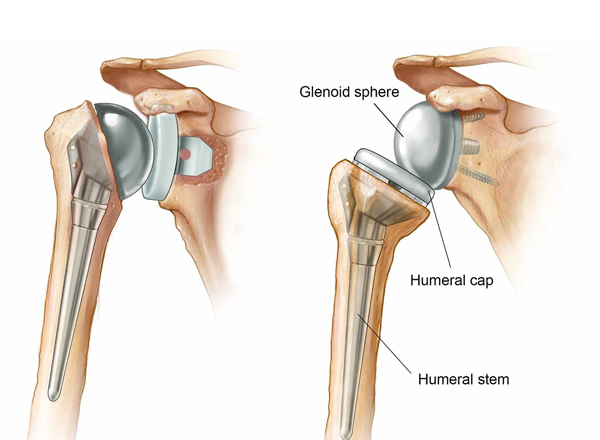
Total shoulder replacement, also known as total shoulder arthroplasty (TSA), is a tremendously successful procedure for treating the severe pain and stiffness that often result at the end stage of various forms of arthritis or degenerative joint disease of the shoulder joint. The primary goal of shoulder replacement surgery is pain relief, with a secondary benefit of restoring motion, strength, function, and assisting with returning patients to an activity level as near to normal as possible. Many patients return to the sports they love like tennis, golf, and swimming, while also pursuing personal health initiatives such as individual training, yoga and pilates.
Painful shoulder arthritis refers to the disappearing of the normally smooth cartilage surfaces of the shoulder, which permit the ball and socket to smoothly glide against one another. This disappearance of cartilage covering results in a "bone on bone" joint and can be quite painful. Thus new surfaces provide the answer for restoration of comfort.
The actual surgery involves replacing the damaged humeral head (or joint “ball”) with a metal ball, and putting a new smooth plastic surface on the glenoid (called the “socket”). Metal on plastic surfaces (rather than metal on metal) are the hallmark of virtually all shoulder replacement implant systems. Partial shoulder replacement (or hemi-replacement) may also be indicated with certain severe shoulder fractures of the humeral head. This technique requires the replacement of the ball component only.
The surgeon begins by separating the deltoid and pectoral muscles, accessing the shoulder in a largely nerve-free area to minimize nerve damage. The shoulder is covered by the rotator cuff, which must be opened by cutting one of the anterior (front) rotator cuff muscles. This “opens the door,” allowing the surgeon to view and manipulate the arthritic parts of the shoulder ball and socket.
After the arthritic sections have been removed, the surgeon inserts the implant socket, ball, and stem components, closes and stitches the rotator cuff muscle, and stitches and cleans the incision, after which a bandage is applied as a temporary covering.